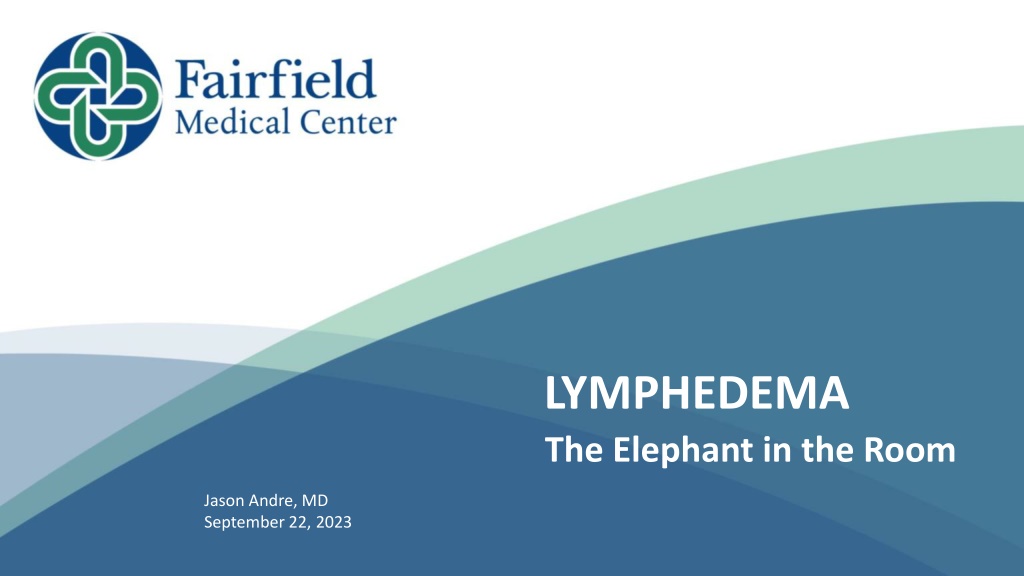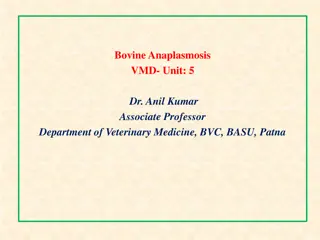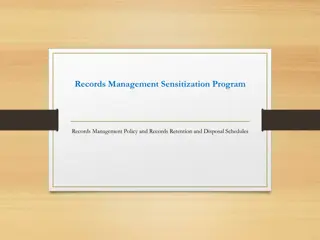Understanding Lymphedema: Causes, Classification, and Management
Lymphedema is an abnormal accumulation of fluid and tissue caused by lymphatic system issues. It can be primary or secondary, with various underlying factors such as cancer, infections, and trauma. Management involves identifying the cause, classification, and appropriate treatment strategies.
Download Presentation
Please find below an Image/Link to download the presentation.
The content on the website is provided AS IS for your information and personal use only. It may not be sold, licensed, or shared on other websites without obtaining consent from the author. Download presentation by click this link. If you encounter any issues during the download, it is possible that the publisher has removed the file from their server.
Presentation Transcript
LYMPHEDEMA The Elephant in the Room Jason Andre, MD September 22, 2023
Objectives Objectives Define lymphedema Classification of lymphedema Discuss etiology Discuss lymphedema presentation Work up for lymphedema Management of lymphedema
LYMPHEDEMA LYMPHEDEMA Definition The abnormal accumulation of interstitial fluid and fibroadipose tissue resulting from injury, infection, or congenital abnormalities of the lymphatic system.
LYMPHEDEMA LYMPHEDEMA Classification Primary Direct cause of lymphedema may not be known and can develop at any time during life Secondary Result of another condition or treatment of another condition Much more common than primary
PRIMARY LYMPHEDEMA PRIMARY LYMPHEDEMA Congenital lymphedema Present at birth or within first year of life May be familial or sporadic More common in females Lymphedema praecox Most common PRIMARY cause Most often during puberty 4:1 ratio female to male Lymphedema tarda Least common Occurs after age 35
SECONDARY LYMPHEDEMA SECONDARY LYMPHEDEMA Cancer or Cancer Treatment Melanoma, GU, or gynecologic tumors Think pelvic lymph node disruption Incidence of lymphedema related to cancer in LE 20% Incidence increase with use of radiation therapy following lymph node removal Direct nodal invasion with melanoma can cause lymphedema as well Kaposi sarcoma can involve cells lining lymphatic channels AIDS or solid organ transplant Upper extremity melanoma and breast cancer
SECONDARY LYMPHEDEMA SECONDARY LYMPHEDEMA Infection Post operative infection following LND Cellulitis Filariasis Most common cause worldwide Affects over 120 million
SECONDARY LYMPHEDEMA SECONDARY LYMPHEDEMA Trauma Traumatic injuries can also disrupt lymphatic system Cause of 10% of post traumatic edema Degloving injuries Multiple fractures Compartment syndrome
SECONDARY LYMPHEDEMA SECONDARY LYMPHEDEMA Orthopedic Surgery Post surgical edema Total hip and total knee Disruption of lymphatic channels
SECONDARY LYMPHEDEMA SECONDARY LYMPHEDEMA Chronic Venous Insufficiency Can be challenging to differentiate from lymphedema but can also lead to lymphedema Mixed CVI and lymphedema is common and known as phlebolymphedema CVI leads to excess fluid load at tissue level overwhelming lymphatic system which can ultimately lead to lymphedema
SECONDARY LYMPHEDEMA SECONDARY LYMPHEDEMA OBESITY Most common referral we get in our office for lymphedema BMI > 50 is independent risk factor for lymphedema Etiology unclear but thought to involve increased production of adipose tissue and retention of fluid in these tissues
LYMPHEDEMA PRESENTATION LYMPHEDEMA PRESENTATION History Age of onset Affected areas Progression of symptoms Restricted motion? Trauma? Medical/surgical history
LYMPHEDEMA PRESENTATION LYMPHEDEMA PRESENTATION Examination Skin turgor Contralateral limb exam if unilateral Can you pinch or pick up fold of skin base of 1st toe (Stemmer sign) Negative does not rule out lymphedema Pitting edema? Not present with advanced lymphedema; involves fat deposition Buffalo hump Edema extending onto foot Skin overgrowth, subcutaneous fibrosis Toe edema
LYMPHEDEMA LYMPHEDEMA Staging International Society of Lymphology Stage 0 Subclinical, pt may have some sensation of swelling Stage 1 Accumulation of fluid high in protein (unlike venous edema) Limb elevation may reduce edema Stage 2 More solid organ changes Elevation alone rarely works Skin may have pitting Stage 3 Fibrosis and adipose deposition limit pitting Acanthosis may occur Skin thickens Warty growth
LYMPHEDEMA LYMPHEDEMA Work up Venous ultrasound Evaluate for DVT and venous reflux disease CT or MRI Enlarged LNs that can obstruct flow Increased interstitial fluid Skin thickening Increased fat density Lymphatic imagining Important if patients undergoing surgical management
LYMPHEDEMA MANAGEMENT LYMPHEDEMA MANAGEMENT Conservative Therapy Skin care Weight management Compression therapy Physical Therapy Pneumatic compression devices
LYMPHEDEMA MANAGMENT LYMPHEDEMA MANAGMENT Skin Care Protein rich fluid from lymphedema triggers inflammation Dry skin Decreased elasticity More susceptible to infection/cellulitis Ulcerations Good skin moisturizer maintains skin health Early treatment with antibiotics for suspected infections
LYMPHEDEMA MANAGEMENT LYMPHEDEMA MANAGEMENT Compression Therapy KEY modality in treatment of limb edema Decrease interstitial fluid production and accumulation Multilayer compression bandages Compression garments Major dependence on patient compliance Provides the GREATEST volume reduction in limbs especially in early stages Once edema decreases, new size compression may be required
LYMPHEDEMA MANAGEMENT LYMPHEDEMA MANAGEMENT Physical Therapy Complete decongestive therapy Manual lymphatic drainage Filling of cutaneous lymphatics Improves expansion and contraction of lymphatic channels, trying to restore normal physiologic function Exercises taught to augment lymphatic flow IMMEDIATE placement of compression garments to maintain volume contraction CDT achieves on average 31-73% volume reduction
LYMPHEDEMA MANAGEMENT LYMPHEDEMA MANAGEMENT Pneumatic Compression Can be used to augment CDT and compression therapy Works to encourage drainage through the lymphatic channels Ideally with inflation and deflation in rhythmic progressive fashion STILL NEED COMPRESSION AFTER IPC
LYMPHEDEMA MANAGEMENT LYMPHEDEMA MANAGEMENT Surgical Management Microsurgery major component with anastomoses of lymphatic channels Typically reserved for Stage 3 Lymphaticovenous anastomosis Bypasses diseased lymphatic system into venous drainage system Free lymph node transfer Reductive surgery Liposuction Excision of adipose and tissue Direct excision of tissue up to deep fascia Skin graft Maintain dermis Direct closure
LYMPHEDEMA LYMPHEDEMA Take Home Messages Numerous causes for lymphedema exist and a thorough history is necessary Symptoms include swelling, skin changes, restricted motion Conservative therapy is key and can be initiated by anyone Weight loss Skin care COMPRESSION PT referral to lymphedema specialist (we have one in our system) DVT study and venous reflux study
QUESTIONS? QUESTIONS?

















































